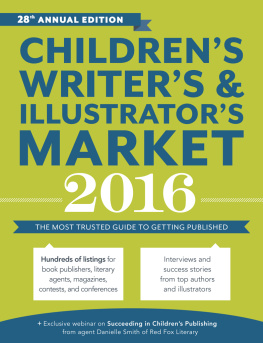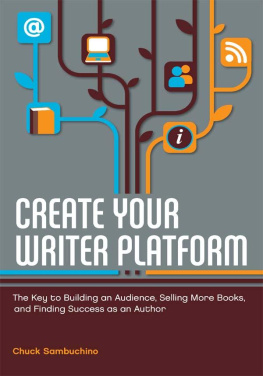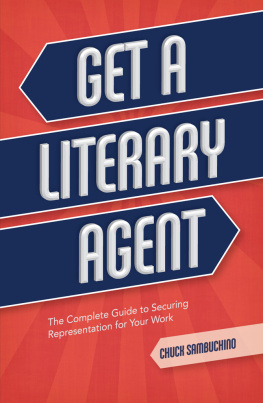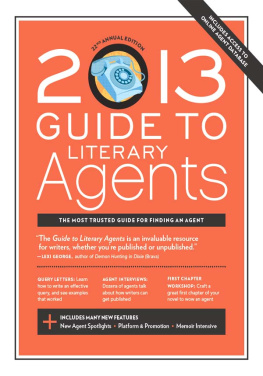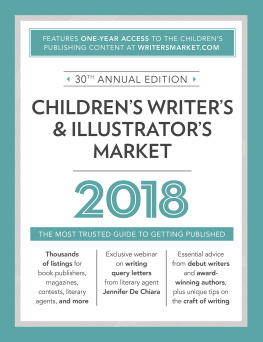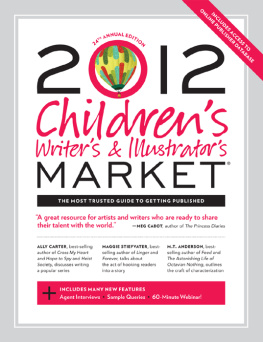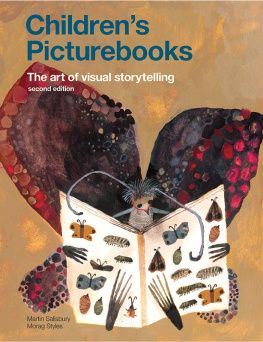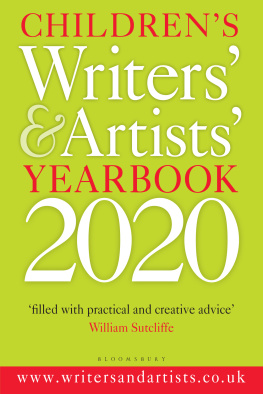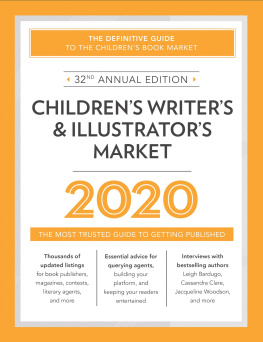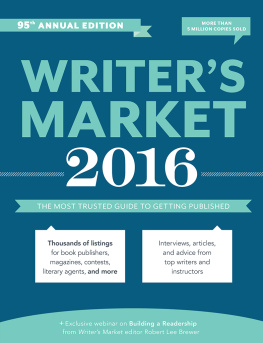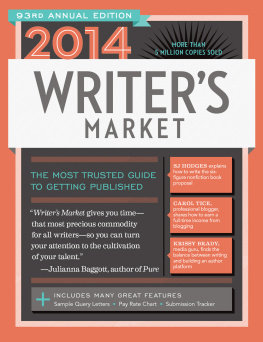Contents
Guide
CHILDRENS WRITERS & ILLUSTRATORS MARKET 2016
28th ANNUAL EDITION
Chuck Sambuchino, Editor
Nancy Parish, Contributing Editor

WritersDigest.com
Cincinnati, Ohio
CONTENTS
FROM THE EDITOR

PHOTO: Al Parrish
Flip through the pages of this Childrens Writers & Illustrators Market edition and youll immediately see some cool changes. First of all, weve tried as much as ever to provide plenty of upfront instructional content to burgeoning illustratorsby talking to artists who just finished drawing their first published books, and interviewing professionals whove been working in the field for years. Secondly, weve scoured around for new publishers and found plenty to add. These are book publishers that accept direct submissions for picture books, middle grade, young adult, and more. This way, whether you want to try for a literary agent first, or whether you opt to send your work directly to a traditional publishing house editor, youll have plenty of choices for either pathway.
Its a return to basics. Even 28 years after its first publication, the goal of CWIM remains simple: Give writers lots of markets for their original writing and illustration. In this guide, youll find listings for US publishers, Canadian publishers, literary agents, magazines, conferences, contests, international publishers, and more. If your goal is to create books for children, youve come to the right placeso read on.
Please stay in touch with me at guidetoliteraryagents.com/blog and on Twitter (@chucksambuchino). I love hearing feedback and success stories. (And dont forget to download your free supplemental webinar at www.writersmarket.com/cwim16-webinar.)
Chuck Sambuchino
Editor, Guide to Literary Agents / Childrens Writers & Illustrators Market
Author, How to Survive a Garden Gnome Attack (2010); Get a Literary Agent (2014); Create Your Writer Platform (2012); When Clowns Attack (2015)
GETTING STARTED
HOW TO USE CWIM
Maximize your education.
As a writer, illustrator, or photographer first picking up Childrens Writers & Illustrators Market, you may not know quite how to start using the book. Your impulse may be to flip through the book and quickly make a mailing list, then submit to everyone in hopes that someone will take interest in your work. Well, theres more to it. Finding the right market takes time and research. The more you know about a market that interests you, the better chance you have of getting work accepted. Weve made your job a little easier by putting a wealth of information at your fingertips. Besides providing listings, this directory includes a number of tools to help you determine which markets are the best ones for your work. By using these tools, as well as researching on your own, you raise your odds of being published.
USING THE INDEXES
This book lists hundreds of potential buyers of freelance material. To learn which companies want the type of material youre interested in submitting, start with the indexes.
Editor and Agent Names Index
This index lists book editors, magazine editors, art directors, agents and art repsindicating the companies they work for. Use this specific index to find company and contact information for individual publishing professionals.
Age-Level Index
Age groups are broken down into these categories in the Age-Level Index:
- PICTURE BOOKS OR PICTURE-ORIENTED MATERIAL are written and illustrated for preschoolers to 8-year-olds.
- YOUNG READERS are for 5- to 8-year-olds.
- MIDDLE READERS are for 9- to 11-year-olds.
- YOUNG ADULT is for ages 12 and up.
Age breakdowns may vary slightly from publisher to publisher, but using them as general guidelines will help you target appropriate markets. For example, if youve written an article about trends in teen fashion, check the Magazines Age-Level Index under the Young Adult subheading. Using this list, youll quickly find the listings for young adult magazines.
Subject Index
But lets narrow the search further. Take your list of young adult magazines, turn to the Subject Index, and find the Fashion subheading. Then highlight the names that appear on both lists (Young Adult and Fashion). Now you have a smaller list of all the magazines that would be interested in your teen fashion article. Read through those listings and decide which ones sound best for your work.
Illustrators and photographers can use the Subject Index as well. If you specialize in painting animals, for instance, consider sending samples to book and magazine publishers listed under Animals and, perhaps, Nature/Environment. Because illustrators can simply send general examples of their style to art directors to keep on file, the indexes may be more helpful to artists sending manuscript/illustration packages who need to search for a specific subject. Always read the listings for the potential markets to see the type of work art directors prefer and what type of samples theyll keep on file, and obtain art or photo guidelines if theyre available online.
Photography Index
In this index, youll find lists of book and magazine publishers that buy photos from freelancers. Refer to the list and read the listings for companies specific photography needs. Obtain photo guidelines if theyre offered online.
| L | market new to this edition |
| G | market accepts agented submissions only |
| o | award-winning market |
| A | Canadian market |
| E | market located outside of the U.S. and Canada |
| n | online opportunity |
| C | comment from the editor of Childrens Writers & Illustrators Market |
| B | publisher producing educational material |
| M | book packager/producer |
ms, mss manuscript(s)
SCBWI Society of Childrens Book Writers and Illustrators
SASE self-addressed, stamped envelope
IRC International Reply Coupon, for use in countries other than your own
b&w black & white (photo)
(For definitions of unfamiliar words and expressions relating to writing, illustration and publishing, see the .)
USING THE LISTINGS
Many listings begin with symbols. Refer to the pull-out bookmark (shown later in this article).
Many listings indicate whether submission guidelines are indeed available. If a publisher youre interested in offers guidelines, get them and read them. The same is true with catalogs. Sending for and reading catalogs or browsing them online gives you a better idea of whether your work would fit in with the books a publisher produces. (You should also look at a few of the books in the catalog at a library or bookstore to get a feel for the publishers material.)
Especially for artists & photographers
Along with information for writers, listings provide information for illustrators and photographers. Illustrators will find numerous markets that maintain files of samples for possible future assignments. If youre both a writer and an illustrator, look for markets that accept manuscript/illustration packages and read the information offered under the

